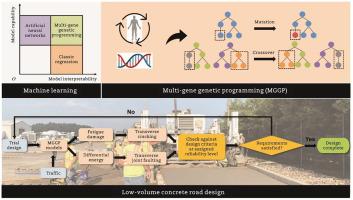Multi-gene genetic programming extension of AASHTO M-E for design of low-volume concrete pavements
Abstract
The American Association of State Highway and Transportation Officials Mechanistic-Empirical Pavement Design Guide (AASHTO M-E) offers an opportunity to design more economical and sustainable high-volume rigid pavements compared to conventional design guidelines. It is achieved through optimizing pavement structural and thickness design under specified climate and traffic conditions using advanced M-E principles, thereby minimizing economic costs and environmental impact. However, the implementation of AASHTO M-E design for low-volume concrete pavements using AASHTOWare Pavement ME Design (Pavement ME) software is often overly conservative. This is because Pavement ME specifies the minimum design thickness of concrete slab as 152.4 mm (6 in.). This paper introduces a novel extension of the AASHTO M-E framework for the design of low-volume joint plain concrete pavements (JPCPs) without modification of Pavement ME. It utilizes multi-gene genetic programming (MGGP)-based computational models to obtain rapid solutions for JPCP damage accumulation and long-term performance analyses. The developed MGGP models simulate the fatigue damage and differential energy accumulations. This permits the prediction of transverse cracking and joint faulting for a wide range of design input parameters and axle spectrum. The developed MGGP-based models match Pavement ME-predicted cracking and faulting for rigid pavements with conventional concrete slab thicknesses and enable rational extrapolation of performance prediction for thinner JPCPs. This paper demonstrates how the developed computational model enables sustainable low-volume pavement design using optimized ME solutions for Pittsburgh, PA, conditions.


 求助内容:
求助内容: 应助结果提醒方式:
应助结果提醒方式:


